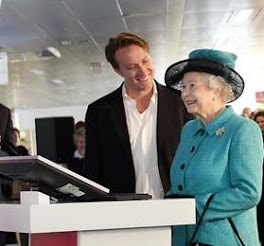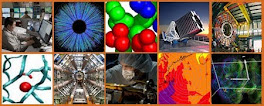Here's what I used to start with - a 3D artefact (Ghanaian trinket), a bed of moist sand, a pair of pliars . Didn't need the spatula... Note the result of the previous experiment (linen stretched over heated face-up trinket, instead of face-down towards linen/ sand)
I then placed a square of linen over the sand tray, and pushed the trinket face down into the linen/sand
Here you can see the indentation left in the linen/sand when the trinket is removed in preparation for heating. The indentation is a guide to where to place the heated trinket into a pre-prepared cavity (but I might try using level sand next time).
Here is then trinket being heated. A sample of linen is used to test its temperature (note that it has charred at the end, meaning the trinket is now hot enough to scorch linen, probably overheated in fact (but in this pilot trial I deliberately set out to produce a 'extreme' end-result that would photograph well)
Here is the hot trinket being pressed down into the linen/sand. At this stage there is no evidence of scorching.
Here is the trinket being removed. It stuck half way - on account of charring at the nose...
First view of full thermal 'footprint' (correction - 'faceprint')
Trinket fully removed, revealing a thermal print of most of its features compared with original. Note the way that the cheeks show up - that did not happen without the sand , i.e. when the linen was pressed down on the trinket face-up. Note the amount of fine detail picked up - the beading on the eyebrows etc. Note too that the image is left-right reversed (like a photographic negative), see the blemish on cheek as a marker.
Here was a second run, using a less-strongly heated trinket. There are two scarcely visible scorch images - side by side - to the left of the trinket. Granted this photograph is lacking in visual impact, but is a better model for the faint image on the Shroud. With trial-and-error it might be possible to reproduce the precise image intensity of the Shroud of Turin.
Postcript: I see elsewhere that my idea has been criticized on the grounds that it contravenes the Universal Fluoresence Principle ;-) The latter in case you are not aware, dear reader, is based on the observation that while the 1532 burn marks on the Shroud fluoresce under uv light, the Shroud image does not. Ipso facto, the Shroud image cannot represent a scorch mark.
Strange, don't you think that one tiny observation should be held to constitute a veto on any idea that the Shroud image is a scorch mark? Now had the original observation been backed up by generating scorch marks by a variety of means, and showing that all, without exception, fail to fluoresce under uv, I might have had greater respect for the idea that the Shroud image could not be a scorch.
Maybe it's the result of having had a strong grounding in organic chemistry as part of my first degree (in Biochemistry) backed up by subsequent research experience - most of it postdoctoral - that I am hugely unimpressed by that single obeservation re the 1532 scorch mark.
What causes certain molecules to fluoresce under uv light? It is usually due to the presence of a number of C=C double bonds in the structure, in linear and/or cyclic regions of the structure. When these chromophores absorb a quantum of uv light, there is often a number of ways that the energy can be subsequently released when promoted electrons drop back between quantised energy states, and in a conjugated diene system it is sometimes the case that the energy difference corresponds to the frequency of light in the visible part of the em spectrum.
So what might encourage the formation of fluorescent chromophores ('fluorochromes') in a fabric that is primarily cellulosic? Answer: pyrolysis, i.e. heating in the absence of oxygen, because the chemical dehydration reactions (elimination of the elements of water, i.e. hydrogen and oxygen atoms in a 2:1 ratio) produce double bonds in the absence of oxygen. But pyrolysis is almost certainly the appropriate description for what happened to the Shroud in the 1532 Chambery fire, where the Shroud was at least partially protected inside a silver reliquary that was engulfed in a fierce fire: the Shroud would have been heated in the presence of limited oxygen, so double bonds and fluorescent properties were highly probable.
In short, one cannot use the Chambery fire as a basis on which to propose that ALL heating and charring results in fluorescence, least of all that the Shroud image is NOT a scorch. The latter could have been formed in the presence of ample oxygen.
It's time the "Universal Fluorescence Principle" was laid to rest, or alternatively put to a more rigorous chemical test.
I might even try doing it myself sometime, given that ultraviolet lamps are not difficult to come by...
Second postscript: Here's a quickie experiment that makes two points: firstly that top-printed images (upper row) are lacking detail compared with those made with a sand bed (lower row), and secondly that any degree of image intensity can be obtained by using a progressively cooler artefact (left to right):
Click to enlarge
Third and final postscript:
How many times recently have you come across this bit of pseudo-scientific twaddle in the Shroud literature?:
The method I describe here does not of course require applying any pigments or other chemicals. One uses conducted heat to alter the surface layer of carbohydrate molecules, which may be cellulose, or, in the view of Raymond Rogers, some kind of starch or simple carbohydrate coating.
How many times recently have you come across this bit of pseudo-scientific twaddle in the Shroud literature?:
"The Shroud image is "extremely thin, one-fifth of a thousandth of a millimeter ... corresponding to the thickness of the primary cell wall of a single linen fiber" . Clearly no medieval or earlier forger could make even a single mark on linen that thin, let alone create the image of a man, front and back, on a linen sheet, of that extreme thinness."
Portion of an illuminated manuscript
Er, one fifth of a thousandth of a millimetre is 200nm. Has the writer never heard of medieval illuminated manuscripts? Does he not know how the gold was applied? Answer: as gold leaf, usually on the tip of a brush. The typical thickness of gold leaf? Yup: 200nm ;-)
The effect of heat is to produce chemical dehydration, i.e. elimination of the elements of water, introducing double bonds into the carbohydrate(s) that cause the scorched linen to absorb appreciably more light at the shorter wavelength (blue) end of the visible spectrum. The scattered blue-deficient light, primarily red and green, is then perceived by the human eye as yellow or pale brown.
Comments invited...
Comments invited...






























5 comments:
Why is the sand essential? That's easily explained. Without it, one gets a tenting effect between raised features which prevents the fabric making contact with lower areas of relief. By pressing into sand, the fabric is made to conform with all parts of the 3D artefact - not just the "pointy" bits. The result is a more accurate rendering of the entire contours of the object.
29th Feb 2012
Discovered today a possible signature for a scorch that has been produced with an underlying sand bed. The combination of hot meal and force that is needed to push the template into the sand has the effect of forcing the fibres apart. So when one holds the linen up to the light one sees multiple points of light in the image area. Pressing the cold template into the linen and sand does not cause this distortion of this fibres.
Does anyone know if the image areas of the Turin Shroud show similar "twinkles" when held up to the light, indicative of force and heat having been applied? The absence of such a signature would be evidence against a sand bed model having been used, needless to say, and indeed might be evidence against there having been
any forceful stretching of linen over a hot template.
Maybe I am making a rod for my own back here, but as a scientist I am interested in discovering the truth - not in pushing a pet theory if it does not fit the evidence or predictions.
The scorch theory like yours has been discussed years ago in shroud studies. The big problem is the spatial distortion cause by translating a curved body onto a flat sheet. The shroud shows an undistorted and foreshortened image: the original object would have to be exactly pre-distorted to exactly account for this translation!
One more problem with the scorch theory: scorched fibers look quite different from the shroud image fibers at a microscopic level. The shroud fibers resemble the result of a Maillard reaction.
Thanks for your thought-provoking blog.
Hello Anonymous (assuming there is just one of you who posted the last two comments this evening, for which I thank you).
I'm more and more doubtful that the image of the face, especially, came from a fully-rounded subject. I think it was a rather flat bas-relief. That would explain the rather sudden cut-off at the left and right peripheries, roughly at the cheekbones. If it were a bas-relief, and a separate one for the head (which is so much better-imaged than the rest of the body) then it did not even have to be a metal template: one could have been made in clay and baked or fired without going to a lot of trouble, and have been able to resist cracking on reheating sufficiently to leave a scorch.
The suggestion that it is a Maillard reaction product is an interesting one, but I doubt whether colour alone could be grounds for thinking so, especially for a faint image (faint scorches produced by heat are yellow rather than brown). There is in any case a simple chemical test that would distinguish a Maillard from a non-Maillard product, namely nitrogen (measured as total nitrogen, say with the Kjeldahl reaction). Maillard reactions require a source of nitrogen, needless to say - but I don't set much store by Rogers' suggestion that putrefaction amines (cadaverine etc) provided the nitrogen, especially if it involves any idea of a 'vapourgraph' which could hardly produce a sharp image - and was hardly likely given the biblical time scale).
Post a Comment